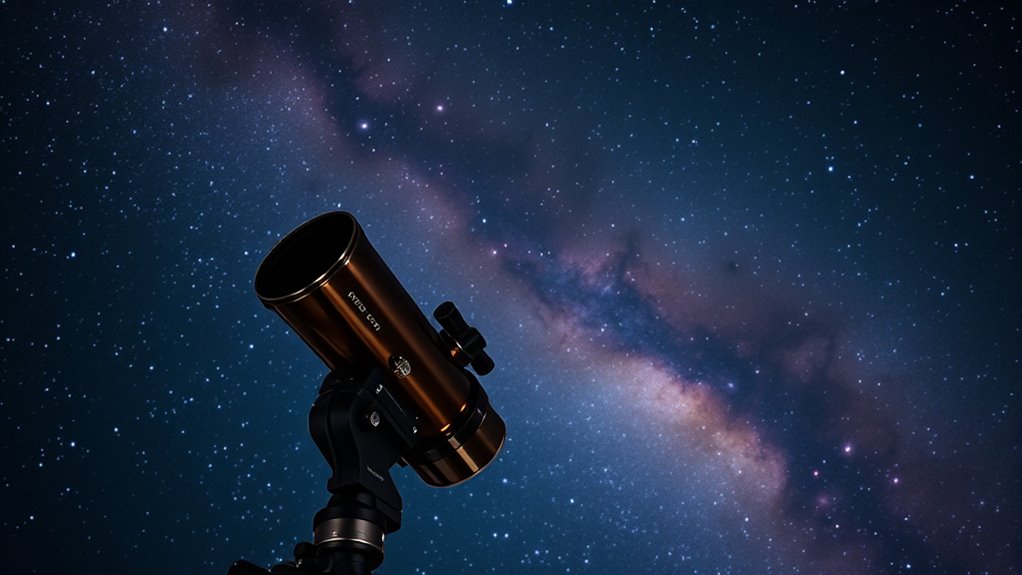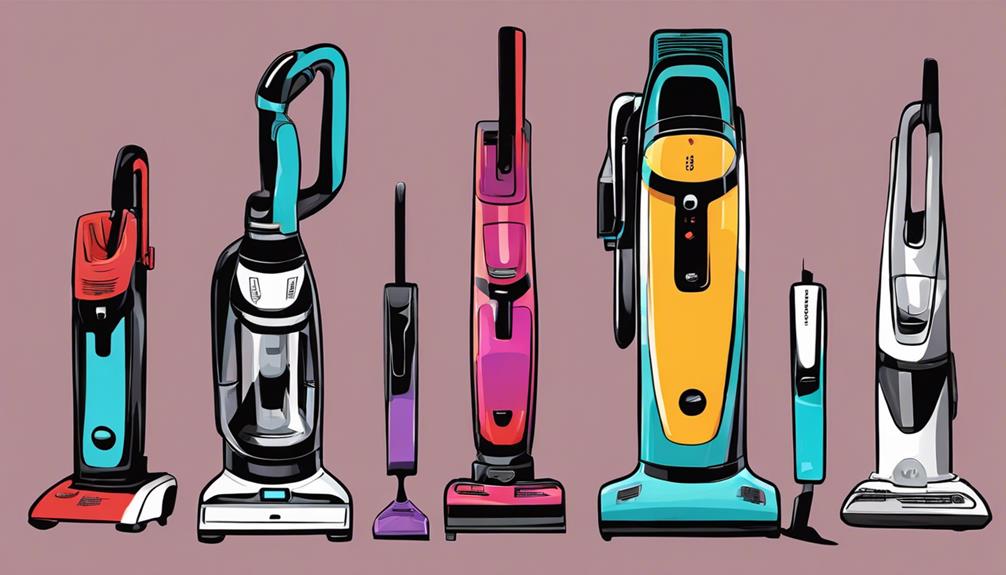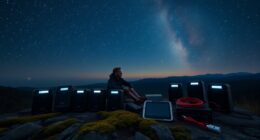If you’re looking to upgrade your astrophotography gear, I recommend considering top 130mm triplet APO refractors like the Explore Scientific FCD100 127mm, the SVBONY SV550, and the Explore Scientific ED102. These scopes feature high-quality ED glass, minimal chromatic aberration, and durable, portable designs, making them ideal for capturing stunning sky shots. Keep exploring further, and you’ll discover even more about these excellent choices that can elevate your astrophotography game.
Key Takeaways
- High-quality ED glass and air-spaced triplet design minimize chromatic aberration for sharp, color-corrected astrophotography images.
- Apertures around 130mm with focal lengths near 950mm provide ideal magnification for planetary and deep-sky imaging.
- Lightweight, durable construction with compatible mounting options ensures portability and stability during field sessions.
- Advanced focusing systems and accessory compatibility support precise imaging setups and full-frame camera use.
- Premium models offer multi-layer coatings and precise collimation for optimal image clarity and minimal internal scatter.
Askar 120APO Telescope for Astrophotography and Viewing
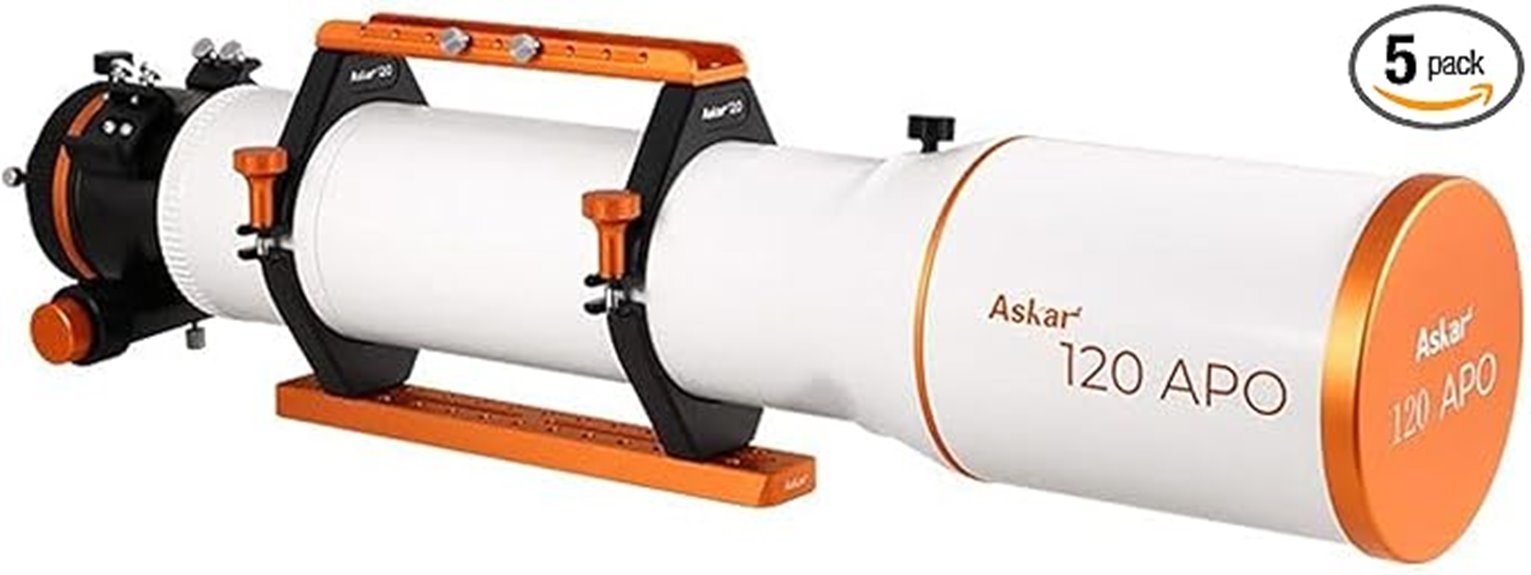
If you’re looking for a high-quality telescope that balances astrophotography and viewing, the Askar 120APO is an excellent choice. It features a 120mm aperture with an F7 focal ratio, making it versatile for both detailed astrophotography and wide-field observation. The triplet air-spaced APO design, with ED glass, reduces chromatic aberration, producing sharp, color-corrected images. Weighing only 5.7kg and measuring 722mm when the dew shield is contracted, it’s portable and easy to handle. The package includes essential accessories like tube rings, a handle, and a dovetail plate, making setup straightforward and efficient for amateurs and experienced astronomers alike.
Best For: amateur and experienced astronomers seeking a portable, high-quality APO refractor suitable for both astrophotography and wide-field viewing.
Pros:
- High-quality triplet air-spaced APO design with ED glass for excellent color correction and sharp images
- Compact and lightweight at 5.7kg with a length of 722mm, making it highly portable and easy to transport
- Comes with essential accessories like tube rings, handle, and dovetail plate, facilitating quick setup and mounting
Cons:
- Price may be higher compared to entry-level telescopes with similar specifications
- Limited aperture size for deep-sky astrophotography of very faint objects
- Requires additional accessories or mounts for advanced astrophotography setups
Explore Scientific FCD100 Series 127mm f/7.5 Carbon Fiber Triplet ED APO Refractor Telescope

The Explore Scientific FCD100 Series 127mm f/7.5 Carbon Fiber Triplet ED APO Refractor Telescope stands out as an excellent choice for serious astrophotographers seeking high image quality and durability. Its 127mm aperture and f/7.5 focal ratio deliver sharp, detailed images with minimal chromatic aberration thanks to the ED triplet design. The carbon fiber construction ensures lightweight strength and thermal stability, ideal for outdoor use. With a 952mm focal length, it provides versatile imaging of deep-sky objects. Although it’s rated with a low customer rating, its optical performance and build quality make it a compelling option for those wanting a reliable, high-performance refractor.
Best For: Serious astrophotographers and amateur astronomers seeking high-quality, durable refractors for detailed deep-sky imaging and observation.
Pros:
- Excellent image clarity with minimal chromatic aberration thanks to ED triplet design
- Lightweight yet durable carbon fiber construction ensures thermal stability and portability
- Versatile focal length (952mm) suitable for a wide range of celestial objects and astrophotography
Cons:
- Low customer ratings (2.3 out of 5 stars) suggest potential issues with user experience or quality control
- Higher price point may be a barrier for casual or beginner users
- Limited online reviews make it harder to assess long-term reliability and performance
SVBONY SV550 Telescope with Accessories for Astrophotography

Designed for serious astrophotographers seeking high-quality images, the SVBONY SV550 Telescope stands out with its 80mm F6 APO triplet lens that delivers sharp, color-accurate views. It comes with a detailed bundle, including the SV209 Field Flattener, which corrects the field for full-frame and half-frame cameras. Its advanced internal light barriers minimize light pollution and reflections, ensuring high contrast. The magnesium alloy focusing seat reduces weight by over 20%, improving portability. With a 180mm dovetail plate and accessories like the M63 extension tube and M48 adapter, this setup supports versatile, stable astrophotography, making it an excellent choice for capturing stunning deep-sky images.
Best For: serious astrophotographers seeking high-quality, portable deep-sky imaging with full-frame camera compatibility.
Pros:
- High-precision 80mm F6 APO triplet lens delivers sharp, color-accurate images.
- Includes SV209 Field Flattener for full-frame and half-frame camera correction, ensuring flat, professional-quality images.
- Lightweight magnesium alloy focusing seat and hollow dovetail plate enhance portability and ease of setup.
Cons:
- Slightly heavier at 8.8 pounds, which may require sturdy mounting equipment for optimal stability.
- Premium features and accessories may come at a higher price point compared to entry-level telescopes.
- Requires some familiarity with astrophotography equipment setup and adjustments for optimal results.
Explore Scientific ED80 Triplet Refractor Telescope for Astrophotography

For astrophotographers seeking exceptional image clarity in a compact package, the Explore Scientific ED80 Triplet Refractor Telescope stands out as an excellent choice. Its air-spaced triplet design with FCD1 HOYA ED glass guarantees minimal chromatic aberration, delivering sharp, detailed images of planets, nebulae, and star clusters. With a 480mm focal length and a portable build, it’s perfect for spontaneous sky sessions or pairing with larger mounts for astrophotography. The collimation system allows precise adjustments, enhancing image quality. Trusted by many, Explore Scientific offers reliable customer support and a solid warranty, making this telescope a versatile and dependable tool for serious astrophotographers.
Best For: amateur and advanced astrophotographers seeking a portable, high-contrast telescope capable of capturing detailed images of planets, nebulae, and star clusters.
Pros:
- Virtually eliminates chromatic aberration with air-spaced triplet design and FCD1 HOYA ED glass
- Compact and lightweight (5.95 pounds) with a 480mm focal length, ideal for portability and spontaneous use
- Precise collimation system with push-pull adjustments enhances image clarity and quality
Cons:
- Average customer rating of 4.0 out of 5 stars from 14 reviews indicates some users may experience minor issues
- Limited aperture (80mm) may restrict deep-sky imaging compared to larger telescopes
- Price and availability may vary, and some users might prefer additional accessories for comprehensive astrophotography setups
Explore Scientific FCD100 Series 80mm Triplet Refractor Telescope

If you’re looking for a portable yet powerful telescope for astrophotography, the Explore Scientific FCD100 Series 80mm Triplet Refractor stands out with its high-contrast optics and advanced glass. It uses genuine Hoya FCD100 ED glass and multi-layer coatings to deliver stunning detail and virtually eliminate chromatic aberration. With an 80mm aperture, 480mm focal length, and f/6 ratio, it gathers ample light for capturing faint celestial objects. Its compact design includes features like an integrated dew shield, Vixen-style dovetail, and a precise 2.5-inch focuser, making setup and focusing easier. It’s a versatile choice for amateurs seeking sharp, vibrant astrophotography results.
Best For: amateur astronomers and astrophotographers seeking a portable, high-contrast refractor with advanced glass and precise focusing for capturing detailed celestial images.
Pros:
- Uses genuine Hoya FCD100 ED glass and multi-layer coatings for stunning clarity and minimal chromatic aberration
- Compact, lightweight design (7 pounds) with integrated dew shield and Vixen-style dovetail for easy portability and setup
- Features a high-quality 2.5-inch hexagonal rack-and-pinion 10:1 two-speed focuser for precise focusing
Cons:
- Limited to an 80mm aperture, which may be less suitable for deep-sky imaging of very faint objects compared to larger telescopes
- May require additional accessories, such as mounts or cameras, to achieve full astrophotography capabilities
- Slightly higher price point compared to basic beginner refractors with similar aperture but fewer advanced features
Celestron Omni XLT 120 Refractor Telescope

The Celestron Omni XLT 120 Refractor Telescope stands out as an excellent choice for amateur astronomers seeking high-quality optics combined with reliable tracking. Its hand-selected optical glass and fully multi-coated StarBright XLT coatings deliver bright, sharp images with maximum light transmission. The hand-figured optical tube is mounted on a precise German Equatorial CG-4 mount, featuring worm gears and smooth slow-motion controls for accurate tracking. Included accessories like a finderscope, sturdy tripod, and eyepiece make setup straightforward. Plus, the free Starry Night software enhances your learning experience. It’s a versatile telescope perfect for detailed celestial observation and astrophotography, especially for enthusiasts ready to elevate their sky shots.
Best For: amateur astronomers and sky enthusiasts seeking high-quality optics and reliable tracking for detailed celestial observation and astrophotography.
Pros:
- Hand-selected optical glass with fully multi-coated StarBright XLT coatings for bright, sharp images
- Precise German Equatorial CG-4 mount with worm gears and smooth slow-motion controls for accurate tracking
- Includes essential accessories such as finderscope, sturdy tripod, and educational software for an all-in-one observing experience
Cons:
- May require some experience to fully utilize the advanced features and mount mechanics
- Heavier and larger, which could affect portability and ease of setup for beginners
- Price point might be higher compared to entry-level telescopes with simpler mounts
Explore Scientific FCD100 Series ED102 Refractor Telescope

When searching for a high-performance refractor perfect for astrophotography, the Explore Scientific FCD100 Series ED102 stands out with its exceptional optical clarity and chromatic correction. Its 102mm aperture and f/7 focal ratio deliver sharp, detailed images, while the 714mm focal length offers versatile framing options. The air-spaced aluminum triplet design, using genuine HOYA FCD100 ED glass, guarantees minimal chromatic aberration. With proprietary multi-layer coatings, it provides high contrast and clarity. Weighing just under 11 pounds, it’s built for durability and precise alignment. This scope is ideal for astrophotographers seeking excellent image quality combined with reliable construction.
Best For: astrophotographers and high-precision sky watchers seeking a durable, optically advanced refractor with excellent chromatic correction and detailed imaging capabilities.
Pros:
- Exceptional optical clarity with genuine HOYA FCD100 ED glass for minimal chromatic aberration
- Versatile 102mm aperture and f/7 focal ratio ideal for both planetary and deep-sky imaging
- Durable aluminum construction with precise optical alignment ensures reliable performance
Cons:
- Slightly heavier compared to smaller refractors, which may require sturdy mounting options
- Optical tube is sold as OTA only, necessitating additional accessories for complete setup
- High-quality coatings and materials may result in a higher price point than entry-level models
SVBONY SV550 Triplet APO Telescope (122mm F7 ED)
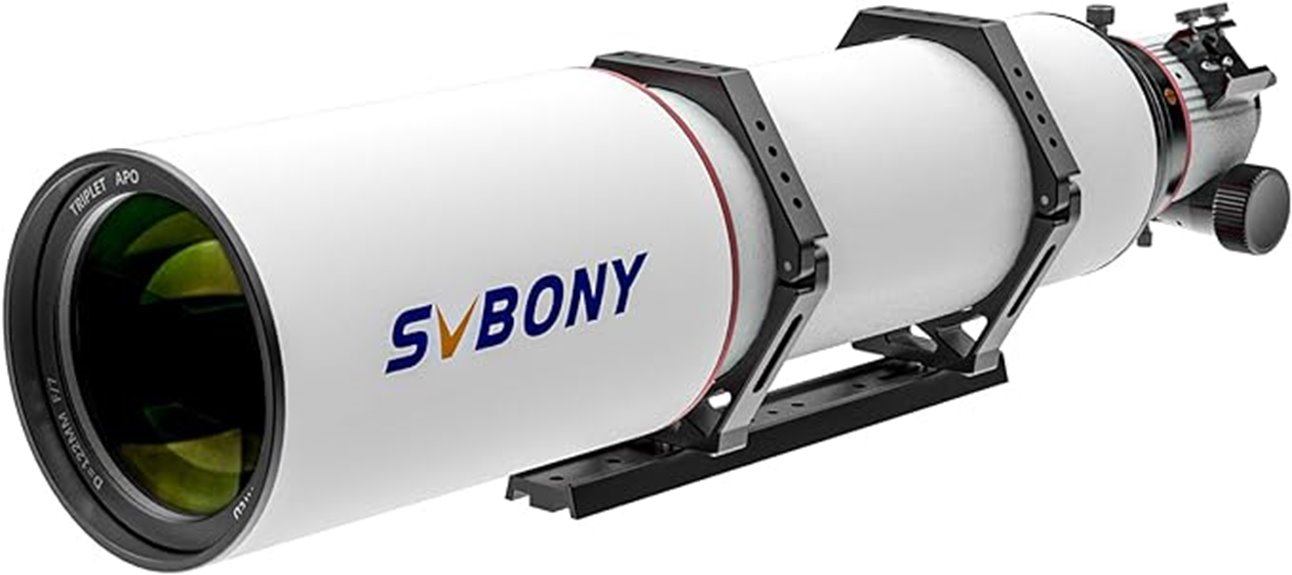
Designed for astrophotographers seeking portable yet high-performance optics, the SVBONY SV550 Triplet APO Telescope combines a 122mm aperture with ED glass to deliver sharp, detailed images with minimal chromatic aberration. Its F7 focal ratio and 854mm focal length make it versatile for both deep-sky imaging and visual observation. Weighing just over 6.4kg, it’s lightweight and compact, perfect for travel. The dual-speed 2.5″ focuser allows precise focus adjustments, while the robust dovetail rail ensures stability. With excellent optical quality and portability, this telescope is ideal for those wanting high-quality images without sacrificing convenience.
Best For: amateur astrophotographers and stargazing enthusiasts seeking a portable, high-performance telescope for detailed deep-sky imaging and visual observation.
Pros:
- High-quality FPL-51 triplet ED lens minimizes chromatic aberration for sharper images
- Compact, lightweight design ideal for travel and field use
- Precise dual-speed 2.5″ focuser allows accurate focusing essential for astrophotography
Cons:
- Slightly heavier than other travel telescopes at over 6.4kg, which may impact portability for some users
- Requires careful handling and setup due to sensitive optical components
- Limited aperture size compared to larger telescopes may restrict the view of very faint objects
Celestron StarSense Explorer DX 130AZ Telescope with Smartphone Dock

If you’re new to astrophotography and want an easy way to explore the night sky, the Celestron StarSense Explorer DX 130AZ Telescope with Smartphone Dock is an excellent choice. Its 130mm Newtonian reflector provides bright, detailed views of the Moon, planets, and deep-sky objects. The StarSense app uses sky recognition technology to identify stars and help you find celestial targets effortlessly. The manual altazimuth mount with slow-motion controls makes tracking smooth and straightforward. Compatibility with most smartphones allows you to use your device as a guide, making stargazing accessible and enjoyable for beginners. It’s a reliable, user-friendly option for those starting their astrophotography journey.
Best For: beginners and amateur astronomers seeking an easy-to-use, app-guided telescope for exploring the night sky with smartphone integration.
Pros:
- User-friendly setup with automated star recognition and target guidance via the StarSense app
- Bright, detailed views of the Moon, planets, and deep-sky objects with a 130mm aperture
- Manual altazimuth mount with smooth slow-motion controls for easy tracking
Cons:
- Slightly heavy at 18 pounds, which may require sturdy setup and handling
- Limited to beginner-level astrophotography; not suitable for advanced imaging needs
- Smartphone dependency means performance can vary based on device compatibility and app updates
Explore Scientific ED102 Triplet Refractor Telescope

The Explore Scientific ED102 Triplet Refractor Telescope stands out as an excellent choice for astrophotographers seeking high-contrast, sharp images of the night sky. Its 102mm aperture and f/7 focal ratio, combined with genuine FCD1 HOYA ED glass and multi-layer coatings, virtually eliminate chromatic aberrations. The air-spaced triplet design ensures stunning detail across Moon, planets, nebulae, and star clusters. Portability is a plus, thanks to its compact size, retractable dew shield, and easy setup with a handle-equipped cradle ring. Perfect for both amateurs and seasoned astrophotographers, it delivers brilliant images with reliable, high-quality optics.
Best For: amateur and professional astrophotographers seeking high-contrast, sharp images of celestial objects with portable, reliable optics.
Pros:
- Combines genuine FCD1 HOYA ED glass with multi-layer coatings for exceptional image clarity and minimal chromatic aberration
- Compact, portable design with retractable dew shield and easy setup features
- Optimized for astrophotography of Moon, planets, nebulae, and deep-sky objects with detailed, high-quality optics
Cons:
- May require additional accessories like mounts or cameras for full astrophotography setup
- Slightly higher price point compared to basic refractors
- Limited to 102mm aperture, which might be less suitable for extremely deep-sky imaging compared to larger telescopes
SVBONY SV105 Telescope Camera, 1.25″ CMOS Astrophotography Camera

For amateur astronomers seeking an easy entry into astrophotography, the SVBONY SV105 Telescope Camera offers a user-friendly solution with its 1/2.8″ CMOS sensor and plug-and-play setup. It captures sharp 1920×1080 video at up to 30 fps and records 2K footage, making lunar, planetary, and terrestrial imaging straightforward. The camera attaches directly to telescopes via a standard 1.25″ thread and works with Windows, Linux, and Android devices. With dark light compensation technology and no driver installation required, it provides real-time viewing and clear images, perfect for beginners enthusiastic to explore astrophotography without complicated equipment.
Best For: amateur astronomers and beginners seeking an easy-to-use astrophotography camera compatible with multiple devices for lunar, planetary, and terrestrial imaging.
Pros:
- Plug-and-play design requiring no driver installation, simplifying setup
- Supports high-resolution 1920×1080 video at up to 30 fps and records 2K footage
- Compatible with Windows, Linux, and Android devices, offering versatile connectivity
Cons:
- Not compatible with iPhones or iPads (iOS devices)
- Limited to 1/2.8″ CMOS sensor, which may be less sensitive than larger sensors for deep-sky imaging
- May require additional accessories or adapters for certain telescope models or filters
Factors to Consider When Choosing 130MM Triplet APO Refractors for Astrophotography

When selecting a 130mm triplet APO refractor, I consider factors like optical quality, focal length, and mounting options to guarantee it meets my astrophotography needs. It’s also important to look at image correction features and accessory compatibility for long-term versatility. These points help me choose a telescope that delivers sharp images and fits my setup perfectly.
Optical Quality and Glass
Optical quality plays a crucial role in maximizing the performance of 130mm triplet APO refractors for astrophotography, and choosing the right glass is essential. High-quality models use extra-low dispersion (ED) glass, like FPL-51 or HOYA FCD1, which considerably reduces chromatic aberration, resulting in sharper images. The air-spaced triplet design separates the optical elements with an air gap, enhancing color correction and overall image clarity. Multi-layer coatings on all surfaces boost light transmission and cut reflections, producing brighter, clearer views. Using genuine optical glass ensures high transparency, durability, and minimal internal scatter—key factors in capturing crisp, detailed astrophotos. Ultimately, rigorous collimation and alignment processes verify optical excellence, ensuring tight star images and consistent performance in your sky shots.
Focal Length and Ratio
Focal length and ratio are key factors that directly impact the versatility and performance of a 130mm triplet APO refractor in astrophotography. The focal length, usually between 714mm and 952mm, influences magnification and field of view. Longer focal lengths provide higher magnification, making them ideal for planetary and detailed deep-sky shots, but they offer a narrower view. Shorter focal lengths deliver wider fields of view and are better suited for capturing large nebulae and star clusters. The focal ratio, ranging from f/6 to f/7.5, determines brightness and exposure times—lower ratios mean brighter images and shorter exposures. Your choice depends on your targets and preferred astrophotography style, balancing magnification with capture versatility.
Mounting and Portability
Choosing the right mount is essential because it directly affects the stability and ease of use during astrophotography sessions. A lightweight, compact mount makes transportation and setup much simpler, especially when heading to remote observing sites. At the same time, a stable, high-quality mount with precise tracking is vital for capturing sharp images during long exposures. Compatibility with various mounting options, like Vixen or Losmandy dovetails, provides flexibility to adapt to different setups. An ergonomic, durable design with quick-release or adjustable features simplifies assembly and disassembly in the field. Proper balancing of the refractor on the mount minimizes vibrations, ensuring smooth, accurate tracking of celestial objects—fundamental for high-quality astrophotography results.
Image Correction Features
When selecting a 130mm triplet APO refractor for astrophotography, paying close attention to image correction features is crucial for capturing sharp, true-to-life images. High-quality multi-layer coatings improve light transmission and reduce reflections, guaranteeing clearer images. Triplet designs with air-spaced ED glass elements virtually eliminate chromatic aberration, resulting in sharper, more accurate colors. Precise collimation systems, like push-pull adjustments and adjustable lenses, are essential for maintaining ideal correction over time. Additionally, top-tier optical coatings and proper alignment minimize distortions and guarantee consistent correction across the entire field of view. Advanced optical features, such as optimized lens spacing and multi-element ED glass, are fundamental for delivering high correction levels suitable for both planetary detail and deep-sky imaging.
Accessories Compatibility
To guarantee your astrophotography setup functions smoothly, it’s essential to verify that your 130mm triplet APO refractor’s accessories are compatible. First, ensure the focuser supports standard sizes like 2.5″ or 3″ to accommodate filters, diagonals, and camera adapters. Check that the rear thread matches common standards such as M48 or M42, facilitating seamless filter and camera attachment. Compatibility with filter wheel systems and flat field adapters is also crucial for high-quality imaging. Additionally, confirm that your mount and dovetail plate match your existing setup to ensure stability during long exposures. Ultimately, look for accessories like field flatteners, extenders, and diagonals that align with your telescope’s optical specs, minimizing vignetting and maximizing image quality.
Build Durability
Since the durability of a 130mm triplet APO refractor directly impacts its performance and longevity, it’s essential to take into account the materials and construction quality. High-quality materials like aluminum or carbon fiber for the optical tube help resist deformation and environmental stress, ensuring the scope maintains optical alignment. Precision construction, including sealed housings and sturdy mountings, protects internal components from dust, moisture, and impacts. Reinforced focusing mechanisms and stable dovetail plates minimize wear and keep the setup aligned over time. Additionally, corrosion-resistant coatings on optical and metal parts extend the refractor’s lifespan, especially in varying weather conditions. Proper handling, storage, and routine maintenance—like using protective caps—are vital for preserving its structural integrity and excellent optical performance for years to come.
Price and Budgeting
The price of 130mm triplet APO refractors varies widely, typically ranging from around $1,000 to over $3,000 depending on features and brand reputation. Establishing a clear budget helps narrow your options and guarantees you select a telescope that fits your imaging needs without overspending. Higher-quality optics, like ED glass and advanced coatings, usually increase the cost but deliver sharper images and better correction. Keep in mind, additional expenses like mounts, accessories, and software can add to your total investment. Comparing prices across different retailers and waiting for discounts or bundle deals can help you get the best value. Setting a realistic budget upfront makes your shopping more efficient and ensures you get a quality instrument that elevates your astrophotography.
Ease of Collimation
Ease of collimation is a crucial factor when choosing a 130mm triplet APO refractor for astrophotography because it directly impacts image quality and setup efficiency. A good collimation system should allow precise adjustments, whether through push-pull mechanisms or screw-type systems. Refractors with integrated collimation screws on the front cell make aligning the optical elements straightforward, reducing frustration. A user-friendly design with clear, accessible adjustment points simplifies realignment after transportation or handling. Since collimation accuracy directly affects image sharpness, selecting a model with easy-to-use adjustments is essential for amateurs and professionals alike. Regular maintenance and simple procedures further guarantee peak performance, saving you time and effort during setup and helping you achieve the clearest, most detailed sky shots.
Frequently Asked Questions
How Do Triplet APO Refractors Compare to Doublets for Astrophotography?
Triplet APO refractors generally outperform doublets in astrophotography because they offer better color correction and sharper images. With three lenses, triplets reduce chromatic aberration more effectively, giving me cleaner, more detailed shots of the night sky. While they tend to be pricier and heavier, I find the improved image quality and reduced post-processing worth the investment, especially when capturing planets, nebulae, or deep-sky objects.
What Maintenance Is Required for 130MM Triplet APO Refractors?
Maintenance for my 130mm triplet APO refractor is surprisingly simple. I regularly clean the lenses with a blower and soft brush, avoiding harsh chemicals. I check for moisture or dust buildup and keep the focuser and mount well-lubricated. Unlike complex systems, it doesn’t require frequent adjustments—just gentle care and storage in a dry, safe place. This keeps my telescope performing at its best for stunning astrophotography.
Can These Telescopes Be Used for Planetary Imaging?
Yes, I can use these telescopes for planetary imaging. Their high-quality optics and precise focusing capabilities allow me to capture detailed images of planets like Jupiter and Saturn. The 130mm aperture provides enough light-gathering power, and the APO design minimizes chromatic aberration, resulting in sharp, vibrant images. I love how versatile they are, making them ideal for both deep-sky and planetary shots, all in a compact, portable package.
What Accessories Optimize Astrophotography With Triplet APO Refractors?
Absolutely, accessories amplify astrophotography with triplet APO refractors. I swear by a sturdy equatorial mount for stability, a high-quality autoguider for precision, and a reliable off-axis focuser for sharp images. Don’t forget filter kits to enhance contrast and reduce glare, along with a dew heater to keep lenses clear. These tools transform your telescope into a stellar shooting machine, ensuring clear, crisp cosmic captures every time.
How Does Aperture Size Affect Image Quality in Astrophotography?
Aperture size directly impacts image quality because larger apertures gather more light, revealing fainter objects and finer details. When I use a bigger aperture, I notice improved clarity, sharper images, and richer colors in my astrophotos. It also helps reduce noise, especially in long exposures. So, if you want better images, choosing a larger aperture allows you to see more of the universe’s details and enhances your overall astrophotography experience.
Conclusion
Choosing the right 130mm triplet APO refractor is like finding the perfect lens for capturing the universe’s beauty. Each of these telescopes offers unique strengths, whether for stunning astrophotos or clear viewing. Take your time, consider your needs, and pick one that sparks your curiosity. With the right setup, you’ll be gazing at the cosmos like a poet with a pen, painting the night sky with wonder.
